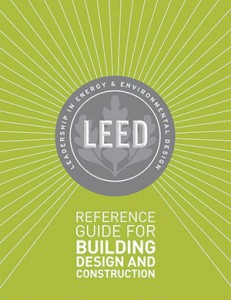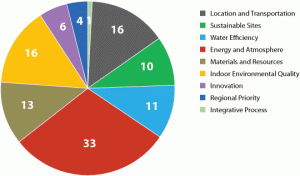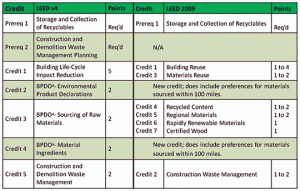The new, fourth version of the U.S. Green Building Council’s Leadership in Energy and Environmental DesignTM Building Design and Construction (BD+C) New Construction and Major Renovations rating system (LEED® v4) contains numerous substantive changes, including a reorganization of the credit categories, a shifting of category point totals, new credits in every category, revisions of existing credits, and a totally revamped materials section. This article provides an overview of changes in LEED v4 most likely of interest to structural engineers. For specific credit information and criteria, and a copy of the LEED v4 rating systems and Reference Guide, readers are referred to the U.S. Green Building Council’s website.
What You Should Know
The spirit of a LEED project is that of a collaborative nature, encouraging dialogue between design disciplines, contractors and the owner. Thus, structural engineers are encouraged to become familiar with the whole of LEED, as well as those credits they are most likely to work with directly. While this article is intended primarily for structural engineers, it cannot provide detail on all of the changes in LEED v4. For a look at other changes, particularly in the area of building products, see LEED v4 – New Categories and Credit Shake Up Ways of Contributing, in a 2014 issue of SMART/dynamics of masonry magazine.
New Organization
LEED v4 boasts 9 distinct categories in which projects can earn points toward certification. A new category, Integrative Process, was added. In addition, the credits related to the building site and location are split into two separate categories in LEED v4, Sustainable Sites (SS) and a new category, Location and Transportation (LT). Those credits related to site development, rain water management, and heat island effect are found in the SS category, and those related to site selection, density, and transit land in the LT category. However, the total number of available points has remained constant at 110 points, and the certification levels remained unchanged. The Figure shows the points allocated to each category with the new categories in green. Structural and civil engineers should pay particular attention to the Materials and Resources, Sustainable Sites, and Location and Transportation categories.
The new category, Integrative Process, focuses on achieving “synergies across disciplines and building systems” through collaborative efforts across disciplines. This credit requires preliminary analysis in the areas of energy and water use, including site conditions, massing and orientation of the building, and the building envelope – all areas where the structural engineer can provide valuable input.
Changes in Sustainable Sites Category
Sustainable Sites includes a new credit on Site Assessment whose goal is to encourage early analysis of the site to inform design. Issues such as topography, hydrology, climate and soils are among the issues to be addressed. This category also had numerous smaller changes to existing credits such as renaming the Storm Water Management credit to Rainwater Management, and combining the Heat Island credits for roof and non-roof surfaces into one credit with slightly revised criteria. Sustainable Sites is a category where the civil/structural engineer will want to closely review the new requirements.
Changes in Energy and Atmosphere Category
The Energy and Atmosphere (EA) category has a new prerequisite for building-level energy metering and two new credits, one for advanced metering and one for demand response programs. Perhaps the most significant change, though, is that the minimum energy standard is now the 2010 edition of ASHRAE 90.1. The change from the 2007 to the 2010 version represents a nearly 20% savings in overall building energy use according to the U.S. Department of Energy. EA credit 1: Optimizing Energy Performance has been adjusted to reflect the more stringent base standard. Structural engineers involved with wall systems would benefit from understanding these changes.
Changes in Materials and Resources (MR) Category/Building Products
Structural systems fall under the broad category of building products, and when it comes to building products, LEED has changed dramatically. In LEED v4 the focus has shifted from “green” attributes of products (recycled content, bio-based content, certified wood, and regional sourcing) to product disclosure. In fact, six of 13 available points in the Materials and Resources (MR) category relate to building product disclosure in the form of environmental product declarations (EPD), supply chain reporting, material ingredient reporting and the like. The Table shows the old and new MR credits side by side.
Say Goodbye to the 500 Mile Radius
A significant change related to building products is the elimination of the regional materials credit. While LEED 2009 included a credit that awarded points for materials and products that were extracted, harvested and manufactured within a 500 mile radius of the project site, this is no longer a stand-alone credit in LEED v4. According to USGBC responses to public comment during the LEED v4 development process, the former regional materials credit did not necessarily achieve the desired environmental benefits, and so the decision was made to focus on the benefits of supporting the local economy. As a result, regional sourcing now applies to products that are extracted, manufactured and purchased within 100 miles of the project site. This attribute is used only as a multiplier within the Building Product Disclosure and Optimization credits (MR credits 2, 3 and 4).
You Can’t Meet the Requirements with the Structural Frame Alone
The limit on the contribution of structure and enclosure materials toward meeting the minimum criteria for the Building Product Disclosure and Optimization credits (MR credits 2, 3 and 4) is another important change in LEED v4. Structure and enclosure materials may not contribute toward more than 30% of the value of compliant building products for some options within these credits. This does not mean that such products cannot be used in higher amounts, but only that they are limited to 30% of the total by cost when doing the calculations.
Think More about Building Renovation and Reuse
MR Credit 1, Building Life-Cycle Impact Reduction, incorporates the former Building Reuse and Material Reuse credits and gives more weight (points) to reuse of whole buildings than the previous versions of LEED. Options 1, 2 and 3 focus respectively on reuse of historic buildings, abandoned or blighted buildings, and other building and material reuse, and are worth up to 5 points. Option 4 awards 3 points for new construction that meets whole building life cycle assessment (LCA) criteria that includes a reduction in global warming potential. LCA gives a bigger picture than looking only at single-attribute criteria (i.e. recycled content) and considers the full life of a product, which is a good thing; however, databases for LCA for building products are not robust, nor up-to-date in some cases.
EPD is the New Buzzword
MR Credit 2, Building Product Disclosure and Optimization – Environmental Product Declarations, is a new credit in LEED v4. This credit has two options, worth one point each. Option 1: Environmental Product Declaration (EPD) requires use of products with publicly available LCA or EPD. Products are valued differently depending upon the type of declaration, with product-specific Type III EPD having the highest value. Option 2: Multi-attribute Optimization awards one point for selection of third party certified products with environmental impacts below industry average for 50%, by cost, of the total value of permanently installed products in the project. Regional weighting and structure/enclosure limits apply to this option, and the calculation can be somewhat complex. Though development of LCA and EPD requires significant investment from product manufacturers, availability of LCA and EPD for building products continues to grow. Several common structural and enclosure products have, or are working on, LCA and EPD for their products.
Do You Know Where That Came From?
MR Credit 3, Building Product Disclosure and Optimization – Sourcing of Raw Materials, rewards reporting of raw material sourcing practices. Option 1: Raw Material Source and Extraction Reporting requires use of a specified number of products sourced from manufacturers that have publicly released a report from their raw material suppliers. Like MR Credit 2, products are valued differently depending upon the type of report. Third-party verified corporate sustainability reports are counted at their full value. Self-declared reports are valued at half. Option 2: Leadership Extraction Practices requires use of a minimum dollar value of products that meet criteria for recycled content, bio-based materials, certified wood and material reuse, similar to the criteria found in LEED 2009. This option also includes extended producer responsibility. Regional weighting and structure/enclosure limits also apply.
Do You Know What’s In That?
MR Credit 4, Building Product Disclosure and Optimization – Material Ingredients, has three options that require documentation of the raw material ingredients for building products. Several chemical and ingredient screening programs are listed as compliance paths including the GreenScreenTM for Safer Chemicals, Cradle to Cradle certification, and the Health Product Declaration (for more information, see Resources). Option 1 in MR Credit 4, Material Ingredient Reporting, focuses on reporting of material ingredients and requires use of a specific number of products meeting the listed criteria. Option 2, Material Ingredient Optimization, awards points for selection of products meeting material ingredient certification criteria for at least 25%, by cost of the total value of products in the project. Option 3, Product Manufacturer Supply Chain Optimization, requires selection of materials that, among other things, have a third-party verified supply chain. Regional weightings and structure/enclosure limits apply to both Options 2 and 3 of MR Credit 4.
The First “R” is Reduce
New in LEED v4 is Option 2 in MR Credit 5, Construction and Demolition Waste Management. Option 2, Reduction of Total Waste Material, awards 2 points if the project does not generate more than 2.5 lbs of construction waste per suare-foot of the building’s floor area. This recognition of the value of minimizing waste in products and packaging is long overdue. Option 1, Waste Diversion, now includes a requirement that diversion must include three material streams and 50% diversion for 1 point, or four material streams and 75% diversion for 2 points.
Putting it into Action
As you evaluate product choices on LEED projects, the new LEED v4 requires a paradigm shift from thinking focused on product attributes to consideration of life cycle, product disclosure and waste avoidance, all in the context of collaboration with other design disciplines and input from the contractor and owner. The structural engineer can be a valuable contributor to this process, particularly if educated on the details of commonly-used structural systems and building products.
Resources
LEED v4 puts a focus on product transparency of building products. Understanding the differences between life cycle inventories (LCI), life cycle assessment (LCA), product category rules (PCR), and environmental product declarations (EPD) is vital to navigating the terrain. For those wishing to learn more about the requirements in LEED v4, product disclosure, life cycle assessment and other topics mentioned in this article, the following list provides a starting point for further reading.
LEED v4
LEED v4 rating system and credits – browse by rating system: www.usgbc.org/leed/v4
LEED v4 User Guide (June 2013), www.usgbc.org/resources/leed-v4-user-guide
White paper: LEED v4 Ushering in the Era of Tansparency and Disclosure by PE International, www.pe-international.com/international/resources/whitepapers/detail/whitepaper-leed-v4/
Product Disclosures
Cradle to Cradle Certified Product Standard, www.c2ccertified.org/
GreenScreenTM for Safer Chemicals (“GreenScreen”), www.cleanproduction.org/Greenscreen.v1-2.php
Health Product Declaration, HPD Collaborative, www.hpdcollaborative.org
Life Cycle Assessment, Environmental Product Declarations
ASTM International article on environmental product declarations, www.astm.org/sn/features/environmental-product-declarations-nd12.html
U.S. EPA website on life cycle assessment, www.epa.gov/nrmrl/std/lca/lca.html



